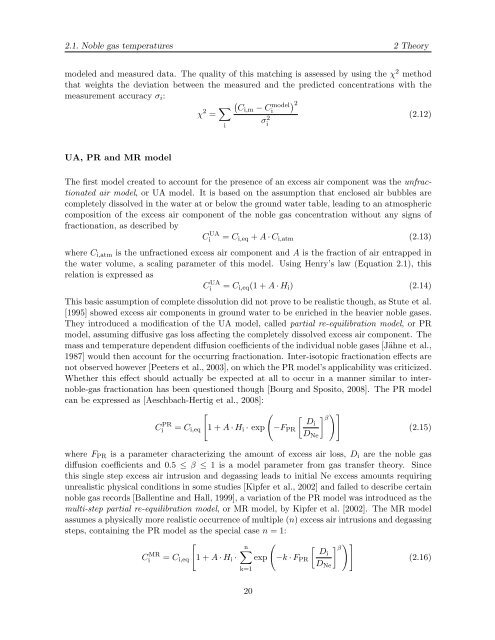Diploma thesis in Physics submitted by Florian Freundt born in ...
Diploma thesis in Physics submitted by Florian Freundt born in ...
Diploma thesis in Physics submitted by Florian Freundt born in ...
Create successful ePaper yourself
Turn your PDF publications into a flip-book with our unique Google optimized e-Paper software.
2.1. Noble gas temperatures 2 Theory<br />
modeled and measured data. The quality of this match<strong>in</strong>g is assessed <strong>by</strong> us<strong>in</strong>g the χ 2 method<br />
that weights the deviation between the measured and the predicted concentrations with the<br />
measurement accuracy σi:<br />
UA, PR and MR model<br />
χ 2 = �<br />
i<br />
�<br />
Ci,m − Cmodel �2 i<br />
σ2 i<br />
(2.12)<br />
The first model created to account for the presence of an excess air component was the unfractionated<br />
air model, or UA model. It is based on the assumption that enclosed air bubbles are<br />
completely dissolved <strong>in</strong> the water at or below the ground water table, lead<strong>in</strong>g to an atmospheric<br />
composition of the excess air component of the noble gas concentration without any signs of<br />
fractionation, as described <strong>by</strong><br />
C UA<br />
i = Ci,eq + A · Ci,atm (2.13)<br />
where Ci,atm is the unfractioned excess air component and A is the fraction of air entrapped <strong>in</strong><br />
the water volume, a scal<strong>in</strong>g parameter of this model. Us<strong>in</strong>g Henry’s law (Equation 2.1), this<br />
relation is expressed as<br />
C UA<br />
i = Ci,eq(1 + A · Hi) (2.14)<br />
This basic assumption of complete dissolution did not prove to be realistic though, as Stute et al.<br />
[1995] showed excess air components <strong>in</strong> ground water to be enriched <strong>in</strong> the heavier noble gases.<br />
They <strong>in</strong>troduced a modification of the UA model, called partial re-equilibration model, or PR<br />
model, assum<strong>in</strong>g diffusive gas loss affect<strong>in</strong>g the completely dissolved excess air component. The<br />
mass and temperature dependent diffusion coefficients of the <strong>in</strong>dividual noble gases [Jähne et al.,<br />
1987] would then account for the occurr<strong>in</strong>g fractionation. Inter-isotopic fractionation effects are<br />
not observed however [Peeters et al., 2003], on which the PR model’s applicability was criticized.<br />
Whether this effect should actually be expected at all to occur <strong>in</strong> a manner similar to <strong>in</strong>ternoble-gas<br />
fractionation has been questioned though [Bourg and Sposito, 2008]. The PR model<br />
can be expressed as [Aeschbach-Hertig et al., 2008]:<br />
�<br />
�<br />
� ��<br />
β<br />
C PR<br />
i<br />
= Ci,eq<br />
1 + A · Hi · exp<br />
−FPR<br />
� Di<br />
DNe<br />
(2.15)<br />
where FPR is a parameter characteriz<strong>in</strong>g the amount of excess air loss, Di are the noble gas<br />
diffusion coefficients and 0.5 ≤ β ≤ 1 is a model parameter from gas transfer theory. S<strong>in</strong>ce<br />
this s<strong>in</strong>gle step excess air <strong>in</strong>trusion and degass<strong>in</strong>g leads to <strong>in</strong>itial Ne excess amounts requir<strong>in</strong>g<br />
unrealistic physical conditions <strong>in</strong> some studies [Kipfer et al., 2002] and failed to describe certa<strong>in</strong><br />
noble gas records [Ballent<strong>in</strong>e and Hall, 1999], a variation of the PR model was <strong>in</strong>troduced as the<br />
multi-step partial re-equilibration model, or MR model, <strong>by</strong> Kipfer et al. [2002]. The MR model<br />
assumes a physically more realistic occurrence of multiple (n) excess air <strong>in</strong>trusions and degass<strong>in</strong>g<br />
steps, conta<strong>in</strong><strong>in</strong>g the PR model as the special case n = 1:<br />
�<br />
�<br />
� ��<br />
β<br />
C MR<br />
i<br />
= Ci,eq<br />
1 + A · Hi ·<br />
n�<br />
exp<br />
k=1<br />
20<br />
−k · FPR<br />
� Di<br />
DNe<br />
(2.16)
















